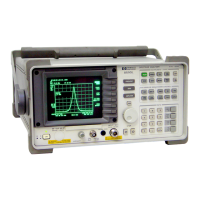Chapter 3 3-13
GPIB Programming
GPIB Operation
NOTE Do not attempt to use this mode for programming. Agilent recommends using
an external instrument controller when programming. See the following
section, “Talker/Listener Mode.”
Talker/Listener Mode
This is the mode that is normally used for remote programming of the analyzer. In
talker/listener mode, the analyzer and all peripheral devices are controlled from an
external instrument controller. The controller can command the analyzer to talk and other
devices to listen. The analyzer and peripheral devices cannot talk directly to each other
unless the computer sets up a data path between them. This mode allows the analyzer to
act as either a talker or a listener, as required by the controlling computer for the
particular operation in progress.
Pass-Control Mode
This mode allows the computer to control the analyzer via GPIB (as with the
talker/listener mode), but also allows the analyzer to take control of the interface in order
to plot, print, or access a disk. During ananalyzer-controlledperipheral operation, the host
computer is free to perform other internal tasks (i.e. data or display manipulation) while
the analyzer is controlling the bus. After the analyzer-controlled task is completed, the
analyzer returns control to the system controller.
NOTE Performing an instrument preset does not affect the selected bus mode,
although the bus mode will return to talker/listener mode if the line power is
cycled. To set the bus mode from the front panel, use the key.
Analyzer Bus Modes
As discussed earlier, under GPIB control, the analyzer can operate in one of three modes:
talker/listener, pass-control, or system-controller mode.
In talker/listener mode, the analyzer behaves as a simple device on the bus. While in this
mode, the analyzer can make a plotor print usingthe OUTPPLOT; or OUTPPRIN; commands.
The analyzer will wait until it is addressed to talk by the system controller and then dump
the display to a plotter/printer that the system controller has addressed to listen. Use of
the commands PLOT; and PRINALL; require control to be passed to another controller.
In pass-control mode, the analyzer can request control from the system controller and take
control of the bus if the controller addresses it to take control. This allows the analyzer to
take control of printers, plotters, and disk drives on an as-needed basis. The analyzer sets
event-status register bit 1 when it needs control of the interface, and the analyzer will
transfer control back to the system controller at the completion of the operation. It will
pass control back to its controller address, specified by ADDRCONT.
Local

